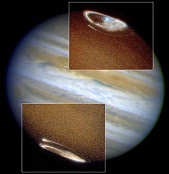Numerical models of stellar and planetary dynamos
 Stellar and planetary magnetic fields, including the best known geomagnetic field, are among the most notable properties of stars and planets and play a crucial part in a variety of cosmic processes.
Stellar and planetary magnetic fields, including the best known geomagnetic field, are among the most notable properties of stars and planets and play a crucial part in a variety of cosmic processes.
The established theory of the nature of these magnetic fields field is that they are generated by a dynamo process driven by convection in the fluid regions of planets and stars. These regions are inaccessible for direct observations, e.g. the Earth's fluid outer core where the geomagnetic field is generated is located at some 2800km below the surface of the planet.
Self-consistent numerical models are thus one of the very few methods available to obtain key insights into the convection-driven dynamo process as well as into a myriad of other aspects of stellar and planetary structure and dynamics where many questions still remain open.
Our approach
In the last 10 years, we have developed cutting-edge numerical models and expertise in simulation of geo- and planetary magnetic fields. We solve the fully nonlinear magnetohydrodynamic equations, derived from first-principles without ad-hoc turbulent and transport models. Although restricted to moderately turbulent regimes by the computing power available at present, this approach is desirable for its self-consistency.
By studying the parameter dependences and the basic physical mechanisms of the convection and the dynamo processes, we hope to achieve a meaningful extrapolation towards the turbulent regimes of actual stellar and planetary magnetic fields.
Why is this research important?
While the state-of-the-art models still fall short of resolving the full details of the geo-, planetary and stellar magnetic fields, it is essential to keep building up capability in this area. For instance, the presence of the geomagnetic field has broad implications for life on our planet. It shields Earth's surface from harmful incoming radiation and protects the many man-made satellites orbiting the planet.
Geomagnetism has been long used as a navigational aid by humans and animals and has fascinated people since antiquity. Similarly important are the studies of solar magnetism, which is so strong that it controls much of the visible solar activity, and of planetary magnetism, which can tell us much about the geology and the formation of planets.

